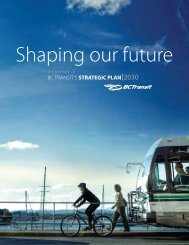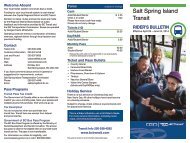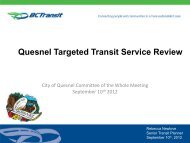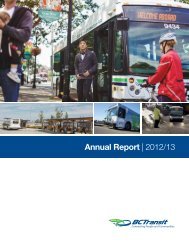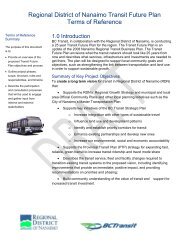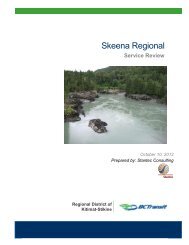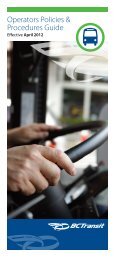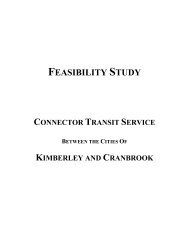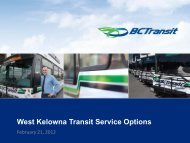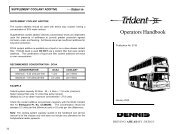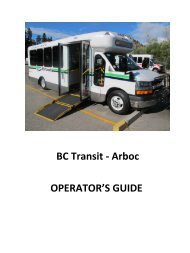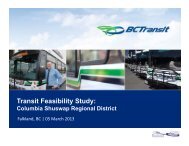ANNUAL REPORT 2008/09 - BC Transit
ANNUAL REPORT 2008/09 - BC Transit
ANNUAL REPORT 2008/09 - BC Transit
- No tags were found...
You also want an ePaper? Increase the reach of your titles
YUMPU automatically turns print PDFs into web optimized ePapers that Google loves.
Further, the challenge in recruiting staff is already easingsomewhat with the economic downturn.<strong>Transit</strong> service is a labour intensive business. To implementthe services anticipated over the next three years will requireover 100 additional staff at <strong>BC</strong> <strong>Transit</strong> to operate the VictoriaRegional <strong>Transit</strong> System and provide the professional andadministrative services supporting the remainder of theprovincial network. Additional new jobs will be requiredby contract operators delivering <strong>BC</strong> <strong>Transit</strong> service in theremainder of the province.In the Victoria Regional transit system, collective agreementswith the Canadian Auto Workers Union and the CanadianOffice & Professional Employees’ Union, representing over600 employees, expire on March 31, 2010. Negotiations withthese bargaining units will likely begin late in 20<strong>09</strong>. A thirdcollective agreement with the Canadian Union of PublicEmployees representing transit supervisors expires onDecember 31, 2010 and negotiations will commence in thefall of 2010.Service Expansion<strong>BC</strong> <strong>Transit</strong> executed the largest service expansion in its historyto meet the goals set in the Provincial <strong>Transit</strong> Plan. Serviceexpansion is reflected in increased ridership including anincrease of 1.3 million passengers or six per cent from prioryear in Victoria conventional transit and 1.6 million passengersor seven per cent from prior year in Municipal Systemsconventional transit.Within Municipal Systems, there were significant ridershipincreases in the following tier 1 communities:•• Prince George - Ridership increased 15.6 per centfrom 2007/08. The continued ridership growthcan be attributed to further expansion and serviceimprovements targeted at the University of BritishColumbia student market.•• Central Fraser Valley – Ridership increased 13.5 percent from 2007/08. Commuter and student marketscontinue to account for most ridership growth.•• Kelowna Region - Ridership increased 13 per centfrom 2007/08. New evening and Sunday service,with the continued effects of the previous year’sroute and schedule restructure were the maincontributors to this increase.Resource constraints on fleet and staffing resulted in serviceexpansion delays aggregating $2.4 million in <strong>2008</strong>/<strong>09</strong>.MAINTENANCEFleet MaintenanceTotal fleet maintenance increased $4.7 million or 20 percent from the prior year. The cost of fleet maintenancesupport has increased significantly over the past five years.Maintenance costs for running repairs, major componentoverhauls and mid-life tune-ups are largely attributable tothe age of the fleet, increasing costs of parts, labour andoutside service providers, and the technological complexityof newer vehicles. Maintenance costs are also expected toincrease due to the lower Canadian dollar, higher shippingand base metal costs. Most parts originate from American orEuropean suppliers.Maintenance costs continue to increase at a rate greater thaninflation (Canadian Consumer Price Index). In Victoria, fleetmaintenance costs exceeded target by $1.07 million or nineper cent. The amount of overtime expended due to theshortage in the targeted number of mechanics in Victoriawas the main contributor to the overage. In the MunicipalSystems, the cost per hour of running repairs increased 16 percent over the previous year.The aging fleet is a driver of maintenance costs. <strong>BC</strong> <strong>Transit</strong>’sfleet replacement and expansion capital plan will in partmitigate some of these cost pressures. During fiscal 20<strong>09</strong>,<strong>BC</strong> <strong>Transit</strong> acquired 77 conventional buses and 50 customvehicles. In addition, 12 conventional buses were retired. Asa result of this fleet replacement and expansion, the averageage of the fleet has improved year over year from 10.5 yearsfor conventional vehicles to 9.8 years.Most replacement parts are purchased directly or indirectlyfrom offshore or the United States. The appreciation in theCanadian dollar seen during 2007/08 and into the first quarter25<strong>BC</strong> TRANSIT <strong>2008</strong>/<strong>09</strong> <strong>ANNUAL</strong> <strong>REPORT</strong>



